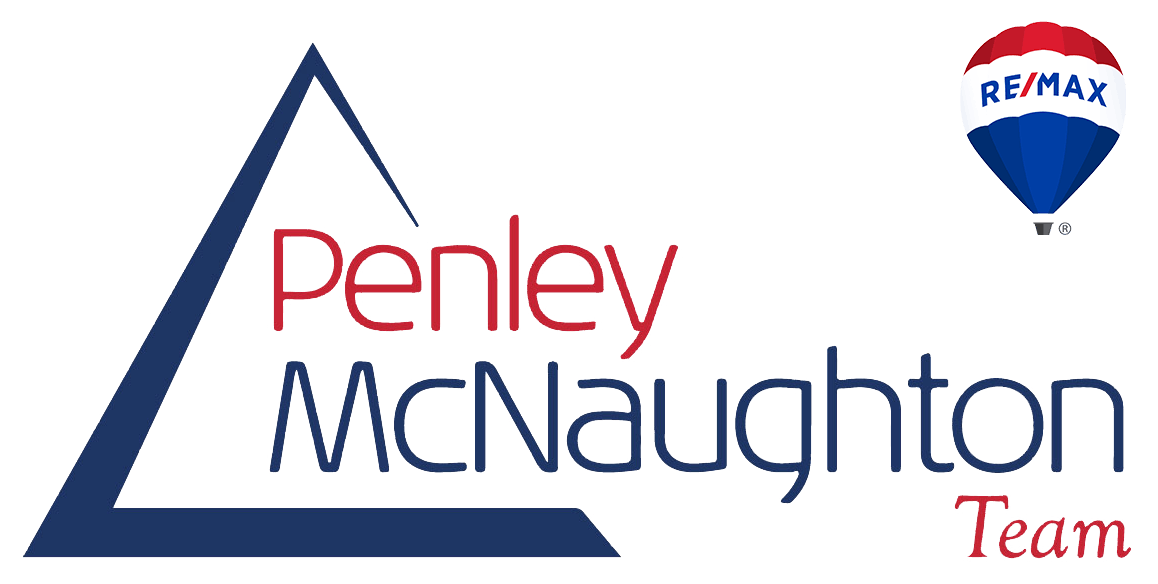Check out the number of resale homes sold and average sale price by district: REAL ESTATE QUARTERLY STATISTICS

market statistics
CREB®'s 2014 economic outlook and housing forecast.
Chief economist Ann-Marie Lurie speaks to the highlights of CREB®’s 2014 economic outlook and housing forecast. Watch the video by clicking below or Click Here to download the full pdf of the 2014 CREB Forecast Report.

Continuing employment growth and two consecutive years of high net migration levels will underpin a 3.6 per cent growth in resale home sales in Calgary this year, with prices increasing by 4.3 per cent.
“In 2014, both sales activity and prices are expected to improve, but not at the same pace recorded in 2013,” said Ann-Marie Lurie, CREB®’s chief economist. “While factors influencing demand will support growth in 2014, new listings and increased competition from the new home sector should alleviate some of the supply pressure in the market.”
The benchmark price on single-family homes in Calgary is expected to reach $467,100, while the benchmark price on apartment condominiums and apartment townhomes will reach $381,798 and $308,690 respectively.
The report notes that homes in surrounding communities provide an affordable choice for those looking for single family product. On aggregate, 2013 annual benchmark prices in surrounding towns were $348,575 versus the $458,017 aggregate within city limits. As supply for lower priced single family declines, demand will continue to grow in surrounding communities, as buyers make lifestyle choices or seek more affordable alternatives to the city.
“Calgary and area is well positioned this year to see growth in the housing market,” said Bill Kirk, 2014 CREB® president. “Price growth in the CREB® trading area will continue to encourage sellers back into the market, pushing up the level of new listings.
“New construction is also expected to add to the housing supply, but not push us into an over-supply situation.”
Lurie noted several positive and negative risk factors could affect the way the year unfolds. For example, if net migration does not ease, expected housing supply growth will likely not meet the demand need, causing price growth to exceed expectations.
Click Here to download the full pdf of the 2014 CREB Forecast Report.
Calgary land developer and homebuilder says city faces ‘looming housing crisis’
Short-term challenges in supply with shortage coming
A promiment Calgary land developer and homebuilder says it’s important that the city keeps its place as one of the most livable cities in the world.
But Alan Norris, president and chief executive of Brookfield Residential, told the Herald in an interview that he has some concerns that an impasse has developed between the industry and city officials. And the city is facing a looming housing crisis with short-term challenges in supply.
‘‘I am fearful of a number of things happening that could cause problems down the road,” he said.
“Innovation and cutting the red tape is definitely something that Mayor Nenshi wants to accomplish. I’m concerned that that is not translating down throughout the rest of city hall. We do end up having in some cases competing interests between different departments. It’s very difficult to figure out which playing field you’re on … I think we have to make sure we have a common vision if we are encouraging innovation and trying to cut tape.
“If we want to be innovative we’ve got to loosen the regs a little bit and make sure that mantra is passed down through the city departments.”
Norris, who spoke at a Calgary Chamber of Commerce luncheon on Thursday, said the city is at an impasse right now for growth and future funding regarding the homebuilding industry.
“I’m just frustrated that we are going to end up in a significant supply constraint environment both for the free market and in the affordable housing segment,” he said.
“The impasse really is that nothing is really progressing through approvals … And there’s a funding and finance impasse right now where the industry and the city do not have an agreement with respect to who’s paying for what.”
He said most municipalities sit down and just figure it out.
“Let’s just figure it out because we are going to be in a huge supply constraint situation on all fronts which Economics 101 will push up the price of housing or people will move to outlying areas or they will just not move here at all,” he said.
“We have an issue here and I don’t see why we can’t sit down and understand this and come to a solution that allows things to move forward.”
Brookfield has built over 60 communities in Calgary in the last 55 years with upcoming ones Bearspaw and North Stoney.
As of June, it has built more than 8,000 homes (single family, semi-detached and multi-family). And it has about 270 employees in Calgary.
The homebuilding industry has recently been in the news during the current municipal election.
Mayor Naheed Nenshi recently reiterated his bid to end what he calls the “sprawl subsidy” — the cost of new suburban infrastructure that isn’t covered by levies the developer sector pays.
It amounts to $33 million per year, or $4,800 per home based on current suburban densities, the mayor said.
The existing five-year deal, which doubled the per-hectare rate developers had previously paid to the city, will expire in 2015, during this coming four-year council term.
“If you keep downloading costs onto the developers, that choice and affordability will erode — and it’s already eroding,” said Guy Huntingford, of the Urban Development Institute, said recently.
By Mario Toneguzzi, Calgary Herald October 10, 2013
Market Trends: Farm Edition 2013
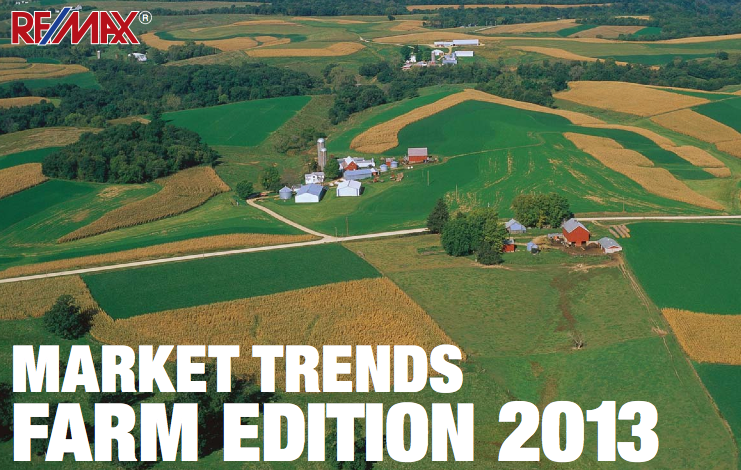 Click here on the image above to view the full report: Canada wide!
Click here on the image above to view the full report: Canada wide!
Central Alberta
Southern Alberta
CALGARY REGIONAL HOUSING MARKET STATISTICS for August 2013
SUMMER SALES STAY STRONG
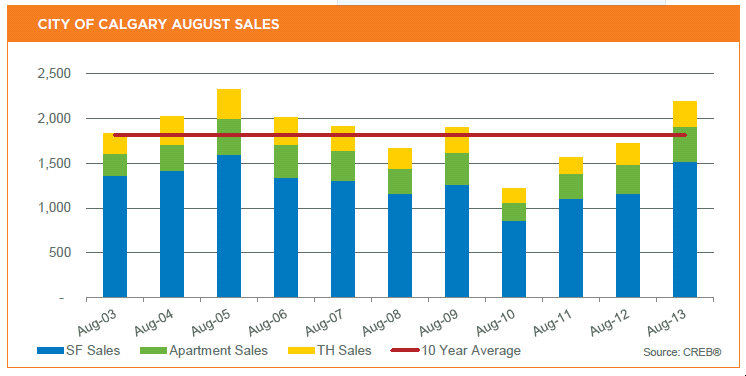
Seller’s market conditions persist, pushing up prices
(click on the photo above to download the full report)
Residential sales within city limits totaled 2,196 units, an 27.5 per cent increase over 2012 and 8.7 per cent on a year-to-date basis.
The level of transactions was well above long-term trends for the month, mostly due to improved activity in the single-family sector. However, on a year-to-date basis, activity is only slightly higher than expectations.
“The sales have been limited by the need for more resale listings,” said CREB® President Becky Walters. “However, August did see more new listings than last year, giving buyers more choice.”
August new listings recorded a year-over-year improvement of 7.4 per cent. While seller’s market conditions persist and total inventory levels keep falling, improvement in new listings helped prevent further tightening in the market despite the sales growth.
Single-family sales totaled 1,517 units in August, a 30 per cent increase over the previous year. Despite strong sales in the past couple of months, year-to-date sales activity has grown by 5.4 per cent, slightly stronger than anticipated.
Click on the following link to download the full report of the Monthly Housing Statistics for August.
City's housing affordability 'among better in Canada'
Calgary’s housing market appears to have weathered the worst floods in memory with the second-strongest quarterly sales gain in four years, says the Royal Bank.
“A strong provincial economy, solid labour market, fast-rising population, and attractive affordability continue to fuel demand for Calgary housing,” said the bank’s latest Housing Trends and Affordability Report, to be released Tuesday.
The RBC report, which measured the April to June period, said monthly resale activity increased for six straight months, including in June (rising 1.1 per cent month-overmonth) and July (up 3.1 per cent). On a quarterly basis, home resales rose 12 per cent.
“While prices recently embarked on a more steeply upward trajectory, the effect of faster-rising prices has yet to undermine affordability in any material way,” said RBC. “In fact, affordability levels in Calgary continue to be among the better in Canada.”
The RBC affordability index determines the proportion of median pretax household income needed to service the cost of mortgage payments, property taxes and utilities.
Its measures for Calgary showed little movement in the second quarter, with two-storey homes rising by 0.5 percentage points to 33.6 per cent, while condominium apartments edged lower by 0.2 percentage points to 19.4 per cent.
And while the report cautions home ownership has become less affordable for the average Canadian, RBC said Alberta homebuyers continued to enjoy a relatively affordable housing market.
“Despite the fact that the market has kicked into higher gear since spring – thereby boosting prices and increasing ownership costs – Alberta continues to be a relatively affordable market,” said Craig Wright, senior vice-president and chief economist with RBC. “We will likely see some disruptions in market activity trickle through in summer data from the floods in southern Alberta; however, we anticipate the strong provincial economy will endure, supporting further housing growth in 2014.”
Nationally, during the second quarter, affordability measures rose for two of the three categories of homes tracked. RBC’s measure for the detached bungalow rose 0.3 percentage points and for the standard two-storey home rose 0.4 percentage points to 42.7 per cent and 48.4 per cent, respectively. The measure for the standard condominium was unchanged at 27.9 per cent.
Vancouver’s affordability measure gained 2.2 points to 82.1 on a detached bungalow, while Toronto’s increased half a point to 54.5.
Calgary Regional Housing Market Statistics – April 2013
TIGHTENED HOUSING SUPPLY CURBS SALES VOLUME
First quarter sales improve in condominium market, while declining in single family sector
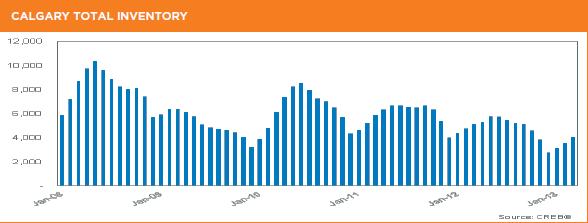
Click on the image above to download your copy of the full report, or click on the following link: CREB® Calgary Regional Housing Market Statistics
The inventory of active homes for sale in Calgary are the lowest March levels in more than five years. The decline in new listings hampered resale sales growth, which declined by more than two per cent in March compared to March 2012.
New listings in March are five per cent lower than levels recorded in 2012, and five per cent lower after the first quarter. The overall active listings stand at just 4,006 units, up from February’s levels but well below the number available one year ago.
“Less resale product available to consumers is ultimately limiting sales growth,” said CREB® President Becky Walters. “In addition, resale homes are selling in less time and with continued upward pressure on prices.”
Walters said buyers have grown accustomed to a market when they have more time to make decisions because there was ample supply. But, as market conditions have tightened, if they are serious about purchasing a resale home, they can no longer significantly delay that decision, she said.
“While market conditions are a far cry from activity witnessed throughout the frenzy in 2006 and 2007, there has been a noticeable change over what became the norm over the past few years.” Walters said.
Single-family, year-over-year sales growth declined by six per cent in March, a reflection of declining supply. Active inventory totaled 2,713 units, 22 per cent lower than levels recorded in 2012, and the lowest March inventory level recorded since 2007. The market balance continues to trend into seller’s territory in this segment causing a year-over-year price increase of nearly nine per cent, for a total of $446,500 in March 2013.
“Tighter rental conditions and continued employment growth has supported housing demand growth,” said Ann-Marie Laurie, CREB®’s chief economist. “However, for those looking for more affordable single family home products, their choices continue to narrow.”
She said new single-family listings under $500,000 are declining at double-digit rates, driving consumers at that price point to either surrounding towns, condominiums or the new home market.
The condominium townhouse market is the only category to record a year-over-year rise in sales activity for the month. This is in part because the level of new listings improved in March 2013 relative to March 2012. Condominium year-over-year apartment sales declined by nearly three per cent in March.
However, after the first quarter, sales activity totaled 830 units a 6 per cent increase over the previous year. Condominium townhouse sales totaled 652 units at the end of the first quarter, a 15 per cent increase over the previous year.
“The condominium apartment market remains in balance,” said Lurie. “While it has moved to the lower end of the spectrum, it remains better supplied then the single family market and the majority of product available is in an affordable price range.”
The benchmark apartment price totaled $257,700 in March, a six per cent increase over the previous year. Meanwhile, the condominium townhouse benchmark price experienced a year-over-year increase of 4 per cent, to $286,800.
“Despite tighter market conditions, it is unlikely that we will have another significant run-up in prices,” said Lurie. “Outside of easing economic factors expected this year, consumers have options in the total housing market.” Said Lurie.
CALGARY'S RESALE CONDOMINIUM MARKET SHOWS SIGNS OF LIFE
Double digit year-over-year condominium sales growth
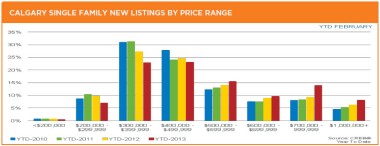
Click on the image above to download the full March 2013 CALGARY REGIONAL HOUSING MARKET STATISTICS
Calgary, March 1, 2013 –Total residential sales for the month of February 2013 totaled 1,711 units, a one per cent decline over the previous year. Accounting for the leap year in 2012, activity in the single family market resembles last year’s activity. However, even with one less day in the February 2013 figures, condominium sales have made significant gains increasing by 13 per cent relative to February 2012.
Year-over-year single family sales growth totaled 1,209 units in the month of February, as supply levels continued to decline, limiting choice for those in the market.
“When new product comes onto the market, buyers are not delaying their purchasing decisions as the majority of homes are selling in less time at prices closer to their list price,” said CREB® President Becky Walters. “The tighter market conditions have supported price growth, however despite the current gains, single family home prices remain below the unadjusted benchmark high of $451,000.”
The unadjusted single family benchmark price for February 2013 was $442,500, a 1.3 per cent increase over the previous month and nine per cent higher than levels recorded in February 2012.
“With less selection in the single family market, particularly at the lower price ranges, more consumers are turning to the condominium market,” said Ann-Marie Lurie, CREB® Chief Economist. “Throughout the downturn there were more single family homes priced under $400,000. However, over the past few years the number of new single family listings in this range represents a declining share of the market, leaving consumers looking for more affordable products.”
Improved sales activity combined with reductions in total inventory levels have provided room for growth in condominium prices. The condominium apartment benchmark price totaled $252,900 in February 2013, a six per cent increase over the previous year. Meanwhile, townhouse condominium prices recorded a year-over-year increase of 4.7 per cent for a total of $283,200 in February.
“During the boom years, Calgary experienced significant growth in the employment sector and shortages in housing supply, ultimately creating frenzy amongst consumers driving up prices at unsustainable rates,” said Lurie. “Condominium prices have since corrected, and while the current price gains are a sign of recovery, the unadjusted condominium apartment and townhome benchmark prices still remain 14 per cent below the peak levels.”
While the average price reflects record levels in Calgary, those numbers can be misleading,” said Walters. “Last year there were more home sales in the higher-end segment of the Calgary market compared to 2007, and this trend has continued into 2013, causing the average price to rise above peak levels.”
CREB® focuses on the benchmark price which is based on the attributes of the home including repeat sales. This pricing methodology provides a better indication of how prices for similar properties have trended over time.
“While our economy does not reflect growth recorded pre-recession and continues to be plagued by short term risk, consumers are feeling confident about the long term prospects of this city and continue to support growth in our housing sector.” Said Lurie.
For more Click Here or on the following link to download your copy of the: March 2013 CALGARY REGIONAL HOUSING MARKET STATISTICS
Calgary region to see MLS sales and prices rising for next two years
The agency said sales in the Calgary census metropolitan area will grow by 1.37 per cent this year to 27,000 units followed by another 2.59 per cent growth in 2014 to 27,700 transactions.
The average sale price is expected to rise by 2.59 per cent this year to $423,000 and by another 2.6 per cent in 2014 to $434,000.
Christina Hagerty, a realtor with Sotheby’s International Realty Canada in Calgary, said she has had a very busy start so far to the year.
“With Calgary’s industries continuing to hire, I see many people coming from other Canadian centres and the U.S,” said Hagerty. “Specializing in the inner-city market, most of the people we meet are either job transfers and want no commute to work, first-time buyers and empty nesters.”
She said rental vacancy rates are at an all-time low and interest rates have remained historically low as well which have been factors in increasing housing demand.
“All the indicators are continuing to confirm our projections last year that Calgary will be leading the nation,” she said. “Affordable mortgages, record low vacancy rates, continued inward migration and low inventory going into the Spring market makes for a year of healthy growth ahead.”
According to the Calgary Real Estate Board, year-to-date until February 21, total MLS sales in the city of 2,498 are up 11.57 per cent compared with the same period last year and the average sale price has risen by 10.63 per cent to $448,635.
For Alberta, the CMHC is forecasting MLS sales to increase from 60,369 in 2012 to 61,000 in 2013 and to 62,400 in 2014.
In the province, the average MLS sale price is forecast to increase from $363,208 in 2012 to $371,200 this year and to $380,700 next year.
The CMHC report also forecast that housing starts in Alberta will fall from 33,396 in 2012 to 31,800 in 2013 but then rise to 32,200 in 2014.
In Calgary, starts are expected to fall from 12,841 in 2012 to 11,800 in 2013 and then rise slightly to 11,900 in 2014.
“The resale market in Calgary is anticipated to remain in balanced territory over the forecast horizon,” said Richard Cho, senior market analyst in Calgary for the CMHC. “Sales in 2013 are forecast to rise for the third consecutive year but at a more tempered pace compared to the previous year. Low mortgage rates, rising incomes and employment growth will continue to help support housing demand. Some sales will also come from renters who migrated to Calgary in the last couple of years.
“The average price has been gradually trending up, and is expected to continue in 2013. Active listings have declined, lowering the selection of available homes and putting pressure on prices.”
– See more at: http://www.calgaryherald.com/business/Calgary+region+sales+prices+rising+next+years/8002644/story.html#sthash.VpluyGkT.dpuf



